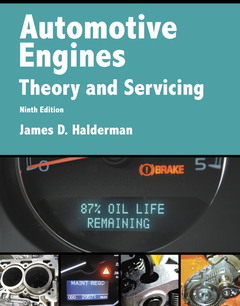Description
Automotive Engines (9th Ed.)
Theory and Servicing
Automotive Systems Books Series
Author: Halderman James
Language: English
Approximative price 123.96 €
In Print (Delivery period: 12 days).
Add to cart608 p. · 21.3x26.9 cm · Paperback
Description
/li>Contents
/li>Biography
/li>Comment
/li>
Prepare tomorrow?s automotive professionals for success.
Automotive Engines: Theory and Servicing,9/e, covers the practical skills that students must master to be successful in the industry. From shop safety and environmental and hazardous materials, to engine assembly, engine installation, and break-in, readers learn the specifics of automotive engine rebuilding, machining, and repair in a new edition of the text long-recognized as a leader in the field. Formatted to appeal to today's technical trade students, Halderman uses helpful tips and visuals to bring concepts to life and guide students through the procedures they'll use on the job.
This book is part of the Pearson Automotive Professional Technician Series, which provides full-color, media-integrated solutions for today?s students and instructors covering all eight areas of ASE certification, plus additional titles covering common courses. Peer reviewed for technical accuracy, the series and the books in it represent the future of automotive textbooks.
Chapter 1 Shop Safety 1
Chapter 2 Environmental and Hazardous Materials 9
Chapter 3 Fasteners and Thread Repair 20
Chapter 4 H and Tools 32
Chapter 5 Power Tools and Shop Equipment 49
Chapter 6 Vehicle Lifting and Hoisting 60
Chapter 7 Measuring Systems and Tools 67
Chapter 8 Service Information 76
Chapter 9 Vehicle Identification and Emission Ratings 85
Chapter 10 Gasoline Engine Operation, Parts, and Specifications 91
Chapter 11 Diesel Engine Operation and Diagnosis 105
Chapter 12 Gasoline, Alternative Fuels, and Diesel Fuels 126
Chapter 13 Coolant 151
Chapter 14 Cooling System Operation and Diagnosis 159
Chapter 15 Engine Oil 178
Chapter 16 Lubrication System Operation and Diagnosis 192
Chapter 17 Engine Starting and Charging Systems 203
Chapter 18 Ignition System Operation and Diagnosis 227
Chapter 19 Emission Control Devices Operation and Diagnosis 251
Chapter 20 Intake and Exhaust Systems 279
Chapter 21 Turbocharging and Supercharging 289
Chapter 22 Engine Condition Diagnosis 301
Chapter 23 I n-Vehicle Engine Service 319
Chapter 24 Engine Removal and Disassembly 329
Chapter 25 Engine Cleaning and Crack Detection 342
Chapter 26 Cylinder Head and Valve Guide Service 352
Chapter 27 Valve and Seat Service 368
Chapter 28 Camshafts and Valve Trains 393
Chapter 29 Pistons, Rings, and Connecting Rods 419
Chapter 30 Engine Blocks 437
Chapter 31 Crankshafts, Balance Shafts, and Bearings 453
Chapter 32 Gaskets and Sealants 473
Chapter 33 Balancing and Blueprinting 482
Chapter 34 Engine Assembly and Dynamometer Testing 494
Chapter 35 Engine Installation and Break-In 525
Appendix 1 Engine Repair (A1) Sample ase-Type Certification Test and Answers 531
Appendix 2 2013 NATEF Correlation Chart 535
Glossary 539
Index 555
Cover important automotive topics in a student-friendly format:
Present topics in short, easy-to-read chapters. The content is broken into small, manageable segments. It features twice as many chapters as competitive texts so that a topic or an entire short chapter can be assigned and taught instead of assigning individual page numbers or questions.
NEW! Streamlined content makes reading easier and enhances comprehension.
Explain how to diagnose faults. In addition to explaining how a system works, most chapters include diagnostic procedures and the steps needed to troubleshoot faults.
Demonstrate how automotive systems are connected. The theory, construction, diagnosis, and service of a particular component or system are presented together, in one location. All of the information that students need to understand a topic is included when it is presented, so there is no need to search through the book for other references to the same topic.
Deliver the most up-to-date standards content. All content in the book has been updated and correlated to the latest NATEF tasks and ASE areas.
Bring the subject to life and facilitate learning:
Engaging art programs support today’s visual learner:
Visualize concepts with full-color photos and line drawings. Photos and line drawings complement the text. The photos show the actual parts involved so that the student can view a good or defective part. The line drawings allow the reader to see what is inside a component and how it works.
NEW! Over 65 new or greatly enhanced full-color line drawings and photos have
These books may interest you

Automotive Brake Systems 179.12 €



